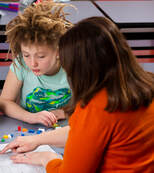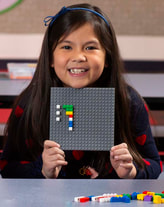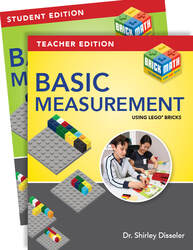 What makes a math curriculum right for homeschooling? There are several factors to consider when you’re searching for the best way to help your child learn math. 1. Student Engagement The best teaching methods work when students enjoy the learning process. Research has shown that “time on task” is a critical element in determining educational success. The longer a student will stay with a task while learning, the more the student will learn. Brick Math is #1 in student engagement. Kids love to use LEGO bricks to learn K – 6th grade math! The process of building math models with LEGO bricks keeps students engaged with the program, which results in learning.  2. Practical Application Math is a conceptual subject, which can make it harder for some kids to learn. Experts agree that finding ways to make math concrete through representation of the math with manipulatives substantially increases a student’s understanding of the math. The entire Brick Math program has been created to make math real and tangible to students, by modeling the math with LEGO bricks. Students who learn with Brick Math often say, “Now I understand the math! I can see it!”  3. Modular Program Math is a subject that builds on prior knowledge. For example: if you haven’t memorized the multiplication tables, you will have trouble understanding factors, and will then be mystified when trying to find the lowest common denominator. Brick Math is built in 11 modules, ranging from Counting and Cardinality in the early years, through Advanced Measurement and Geometry around grades 5 – 6. You can bring in any of the 11 Brick Math modules when your child is ready to learn that subject. Many parents use Brick Math to reinforce a math subject that their child has not learned fully from another math curriculum.  4. Easy to Teach When you are homeschooling your child, you need to be comfortable with the material so you can teach it properly. And especially with math, the teaching methods used when you were younger are not the ones being used today. Brick Math makes the teaching process easy for parents to use. The Teacher Edition of each subject has step-by-step lessons that you follow to teach the topic. There are illustrations of all the brick models you will build, as well as illustrations of the correct models that the student will build, so you’ll know they are learning. Short videos on the Brick Math website show you exactly how Brick Math works, so you’ll feel very confident when you work with your child on the lessons. You’ll know your child is learning, because the Student Edition for each subject includes an assessment in every chapter and a chart to track your child’s progress.  5. Affordable Homeschooling materials can be very pricey, and when you need to buy a new curriculum every year, the cost of so many programs can be prohibitive. Brick Math is a very affordable curriculum: One Teacher Edition ($14.95) and one Student Edition ($9.95) per math subject (less than $25 for each subject). Use the LEGO bricks you already own, or get a Brick Math brick set for $60, which includes all 250 bricks needed for all 11 subjects, plus two 6” x 6” baseplates, packed in a sturdy divided storage box for easy access and clean-up. That’s a total of less than $80 to get started, then $25 to add on new subjects.  6. Based on Sound Academic Research and Practices When selecting homeschooling curriculum, look for programs that are based on the most up-to-date academic research and ideas. Especially in math, you want to be sure your child’s curriculum is keeping up with the latest information. Brick Math was developed by Dr. Shirley Disseler of High Point University, an expert in math education and learning using LEGO bricks. She created the program based on the current findings into how students learn math. The Brick Math program has been tested with thousands of students, and has been shown to be highly effective at helping students learn math in the elementary school years. Parents across the US have been astonished to discover how well their children learn math with Brick Math after trying in vain to learn from other methods. Brick Math is a K-6 math curriculum that uses LEGO® bricks to model 11 different math subjects:
Counting, Addition, Subtraction, Multiplication, Division, Basic Fractions, Basic Measurement, Fraction Multiplication, Fraction Division, Advanced Measurement and Geometry, and Decimals. If you have a student at home who is learning math, check brickmath.com. The website includes videos for both teacher training and direct instruction of students. You can learn more about how Brick Math improves student math test scores and hear what people who are using Brick Math have to say about the program.
0 Comments
 Last month, the Brick Math lesson was about Customary Liquid Measures (cups, pints, quarts, etc.). We got a LOT of comments about how the US should be using metric measures (liters, grams, meters, etc.) like the rest of the world! Well, we can’t control that, but we know that kids need to learn metric measures, too—and luckily, Brick Math also includes lessons on metric measures. So the Brick Math Lesson of the Month for November 2020 is about modeling and converting metric measures and is taken from Basic Measurement Using LEGO® Bricks. To get the November 2020 lesson, and a new lesson each month, sign up here.  The lesson starts with the Teaching Guide. It begins by showing how to model the metric system with bricks, using a 1x3 brick as the base unit (liter, gram, meter) and 1x1 bricks to model the tenfold increases or decreases from the base unit. The model includes the vocabulary you need to talk about the metric system (Kilo, Hecto, Deka, Deci, Centi and Milli). Then, using the model, students learn how to convert from one metric value to another: in this lesson, from the base unit of meters to centimeters (1/100). You can use this method to convert any metric values.  Pages from the Student Workbook are included after the Teacher’s section. Have your student work along with you using these pages to draw their brick models and answer questions about the lesson. It’s important for elementary students to get comfortable with the metric system, even if we here in the US don’t use it in our everyday lives. Students will soon encounter the metric system as they move forward in math, so building a strong foundation (with bricks, of course!) for understanding the metric system is key, typically in grades 2 – 4. Brick Math is a K-6 math curriculum that uses LEGO® bricks to model 11 different math subjects: Counting, Addition, Subtraction, Multiplication, Division, Basic Fractions, Basic Measurement, Fraction Multiplication, Fraction Division, Advanced Measurement and Geometry, and Decimals. It works well for homeschooling, math intervention, enrichment, and as a whole-school program. Materials are simple and are not shared between students. It adapts easily to online instruction. If you teach math or have a student at home who is learning math, check brickmath.com. The website includes videos for both teacher training and direct instruction of students. You can learn more about how Brick Math improves student math test scores and hear what people who are using Brick Math have to say about the program. |
Categories
All
Archives
July 2024
|


